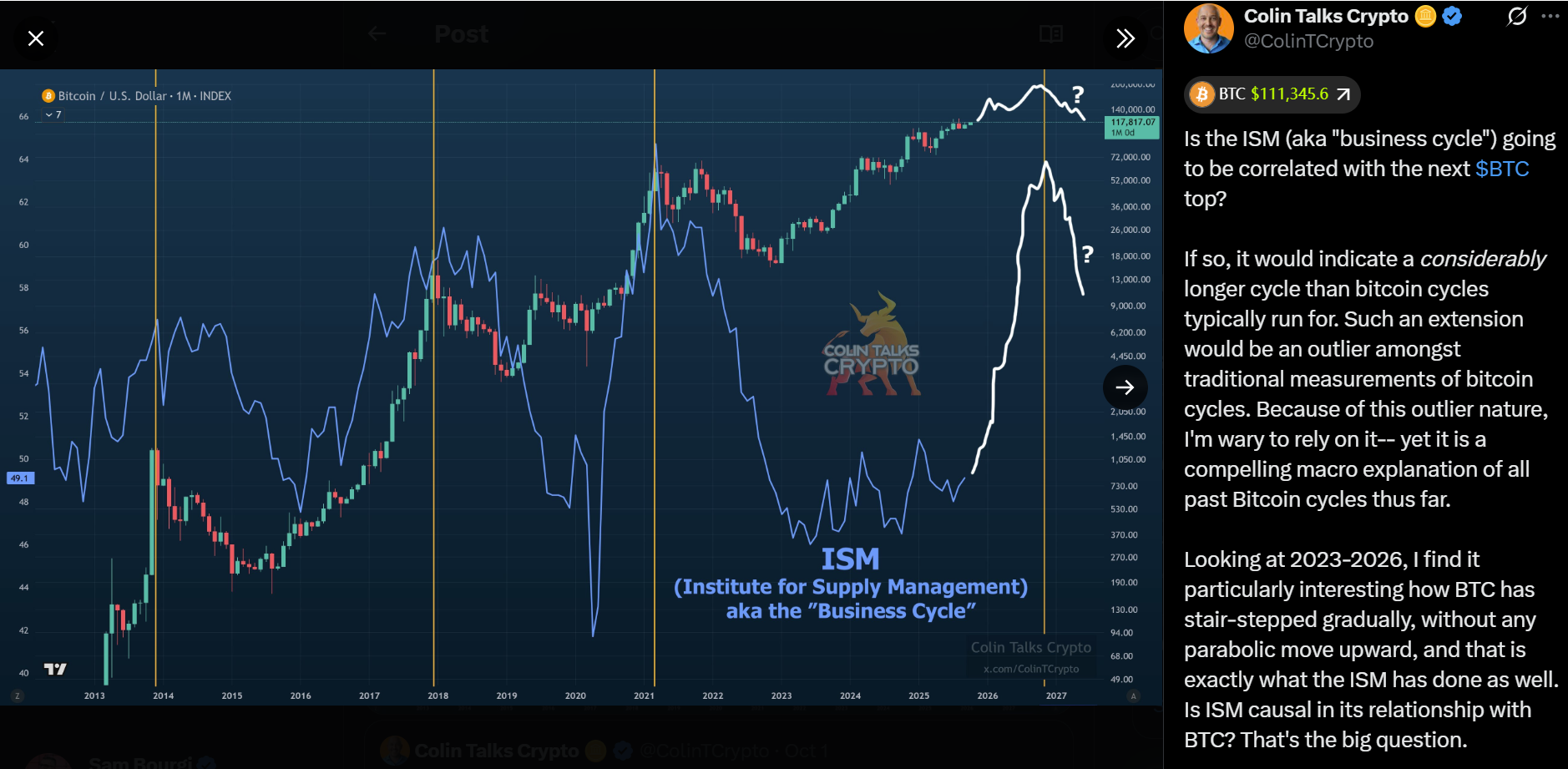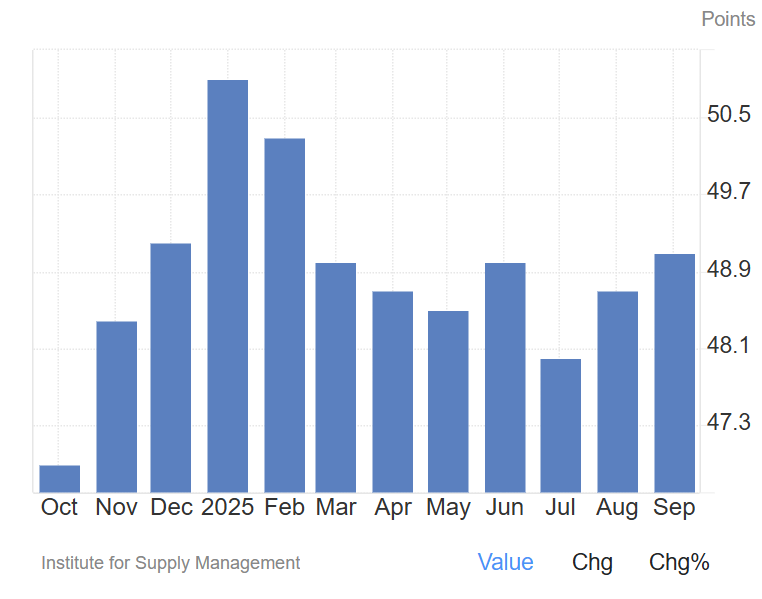Bitcoin market cycles may extend longer due to persistent weakness in the ISM manufacturing PMI, which has historically signaled cycle peaks. With the index below 50 for seven months, analysts predict a prolonged Bitcoin cycle amid ongoing economic headwinds.
-
Historical Correlation: ISM PMI peaks have aligned with Bitcoin’s past cycle tops, as noted by analysts like Raoul Pal.
-
Current Weakness: The PMI remains in contraction territory, indicating slower manufacturing recovery and broader macro challenges.
-
Implications: A sustained PMI below 50 could stretch Bitcoin’s current cycle beyond typical durations, delaying potential peaks.
Explore how weak ISM manufacturing data signals longer Bitcoin market cycles. Discover key correlations and economic insights for informed crypto strategies—stay ahead in 2025.
What is the connection between ISM manufacturing PMI and Bitcoin market cycles?
ISM manufacturing PMI serves as a key economic indicator that has shown a notable correlation with Bitcoin market cycles, particularly in signaling major peaks. Historically, peaks in the PMI have coincided with tops in Bitcoin’s price cycles, a pattern popularized by macro analyst Raoul Pal of Real Vision. This relationship suggests that prolonged weakness in manufacturing activity, as currently observed, could lead to an extended Bitcoin cycle rather than a swift peak.
The Institute for Supply Management’s (ISM) Manufacturing Purchasing Managers’ Index (PMI) tracks U.S. industrial activity, with readings above 50 indicating expansion and below signaling contraction. For seven straight months, the PMI has lingered below the neutral 50 threshold, reflecting ongoing challenges in the sector. This stagnation raises questions about the broader economic recovery and its ripple effects on risk assets like Bitcoin.
Analysts monitoring these trends point to past alignments where Bitcoin’s bull runs concluded around PMI cyclical highs. If this pattern persists, the current subdued PMI could imply a Bitcoin market cycle lasting longer than the typical 4-year halving rhythm, potentially pushing peak timelines into late 2025 or beyond.

Source: Colin Talks Crypto
How does current ISM PMI weakness impact Bitcoin’s price outlook?
The ISM Manufacturing PMI’s persistent contraction, now in its seventh month below 50, underscores macro headwinds that could temper Bitcoin’s momentum. Earlier this year, the index briefly surpassed 50, sparking optimism tied to policy expectations under the incoming administration, but it quickly reverted, highlighting fragile recovery efforts.
Macro-focused crypto analysts, including Colin Talks Crypto, emphasize that all three previous Bitcoin cycle tops have broadly matched the PMI’s oscillating peaks. “It would indicate a considerably longer cycle than Bitcoin cycles typically run for,” Colin observed, based on historical data. This extended timeline might delay Bitcoin’s next major high, as manufacturing weakness signals broader economic drag.
Supporting data from TradingEconomics shows the PMI’s recent modest uptick in September, yet prices rose while exports and imports declined, painting a picture of uneven sector performance. ISM reports indicate that despite these contractions, the manufacturing sector’s shrinking role in U.S. GDP means a PMI above 42.3 often aligns with overall economic growth, offering some buffer against recession fears.

ISM Manufacturing PMI. Source: TradingEconomics
Expert insights from ISM’s surveys reveal ground-level struggles: a purchasing manager in the transportation equipment industry described business as “severely depressed,” with tariffs inflating costs by up to 20% through supply chain surcharges. High tariffs and soft global demand continue to hinder momentum, potentially prolonging the business cycle and influencing investor sentiment toward Bitcoin.
This dynamic isn’t isolated to manufacturing; it ties into wider trade uncertainties and policy shifts. For instance, optimism around business-friendly reforms initially boosted sentiment, but persistent drags like elevated input costs have overshadowed gains. As Bitcoin often mirrors macroeconomic health, a slower industrial rebound could foster a more cautious trading environment, encouraging long-term holding over short-term speculation.
Frequently Asked Questions
What historical patterns link ISM PMI to Bitcoin cycle peaks?
The ISM Manufacturing PMI has aligned with Bitcoin’s past three major cycle tops, as highlighted by analysts like Raoul Pal and Colin Talks Crypto. These overlaps occur when the PMI reaches cyclical highs, signaling economic shifts that coincide with Bitcoin price peaks, providing a reliable macro indicator for cycle timing.
Why is the current ISM PMI contraction prolonging Bitcoin market cycles?
With the ISM PMI stuck below 50 for seven months, it reflects sustained manufacturing weakness amid tariffs and low demand, delaying economic expansion. This environment historically extends Bitcoin’s cycles by muting risk appetite, as investors await clearer recovery signals before driving new highs— a natural response in volatile markets like crypto.
Key Takeaways
- PMI-Bitcoin Correlation: Past cycle tops in Bitcoin have matched ISM PMI peaks, a trend tracked by macro experts for predictive value.
- Ongoing Contraction: Seven months below 50 signals macro headwinds, potentially stretching Bitcoin’s current cycle longer than average.
- Investor Caution: Monitor PMI for expansion above 50, which could catalyze Bitcoin gains; diversify strategies amid uncertainty.
Conclusion
In summary, the interplay between ISM manufacturing PMI and Bitcoin market cycles underscores the crypto asset’s sensitivity to macroeconomic indicators. With persistent PMI weakness pointing to extended headwinds, market participants should prepare for a potentially prolonged cycle, emphasizing patience and data-driven decisions. As economic conditions evolve, staying informed on industrial trends will be crucial for navigating Bitcoin’s path forward in 2025 and beyond—consider reviewing your portfolio alignment with these insights today.
